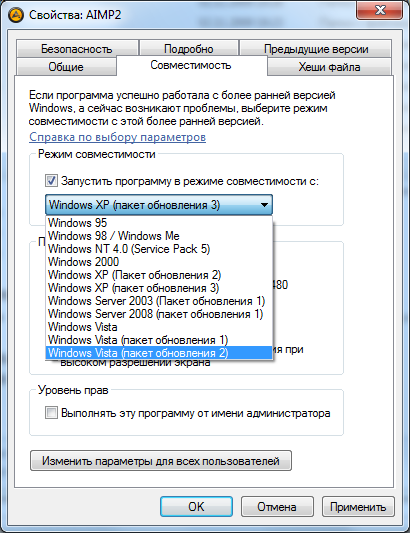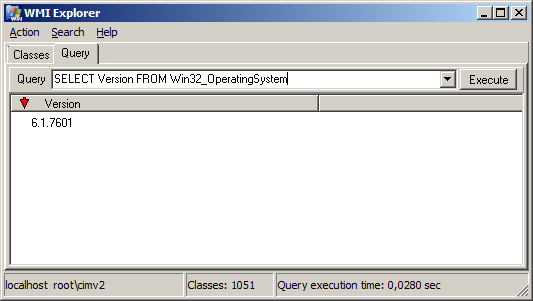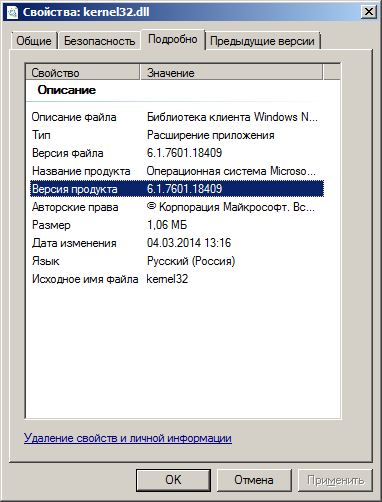How to find out the real version of Windows from compatibility mode
I think everyone at least once faced with a situation where on a modern OS it was not possible to launch an old program, and in this case Windows compatibility mode helped.

The operation of this mechanism is based on the interception of various functions and emulation of their behavior characteristic of the specified version of Windows, for example, registry keys, directories with documents, etc. are emulated. All this is necessary for the program to think that it is running in the selected environment.
If the application is running in compatibility mode, calling GetVersionEx will return a dummy version of Windows, which is probably not suitable for system programs such as OS tweakers. How to be in this case?
In the vastness of the network, I came across a way of detecting by the presence / absence of exported functions in system libraries. Code example:
The solution is interesting, but I do not think it is acceptable, since the release of each version of Windows requires non-trivial support.
From Wikipedia
You can also get a version of Windows from WMI. From the documentation it follows that this can be done with such a request:
Starting WMI Explorer in compatibility mode with Windows XP, you can see that this value is not emulated:

The method works, moreover, it is fully documented, but slow, and requires a lot of code to be pulled into the project by work with WMI.
Perhaps the most elegant and correct way found on the network is to peek at the value in the registry:
Well, let's try:
Unfortunately, having tested it on Windows 7, it turned out that this registry key is emulated. It seems that in previous versions of Windows this method worked, but, alas - now this trick will not work .
I did not check it myself, but they say that the version of the kernel32.dll file matches the version of Windows. On my computer with Windows 7 it is like this:

It’s a very suitable method, but for some reason I personally don’t like it, since there is still an alternative.
Every Windows process has a structure that describes it; it is called PEB. It is filled at the start of the process and contains the download address, a list of loaded modules, command line parameters, and, including, the version of Windows. Below is an example of a module using which you can get a real version of Windows (tested on Delphi 2010 Win32):
The speed of work is instantaneous, nothing superfluous, the only BUT is the undocumented PEB structure, but as you know Microsoft is very concerned about backward compatibility, so with a lot of optimism we can assume that since the description of the structure has been surfing the Internet for a long time, then it is already considered to be documented in Microsoft.
And the conclusions are simple, if you really need to get a real version, then WMI is a great option, but if you need a lightweight solution - see PEB.

The operation of this mechanism is based on the interception of various functions and emulation of their behavior characteristic of the specified version of Windows, for example, registry keys, directories with documents, etc. are emulated. All this is necessary for the program to think that it is running in the selected environment.
If the application is running in compatibility mode, calling GetVersionEx will return a dummy version of Windows, which is probably not suitable for system programs such as OS tweakers. How to be in this case?
Analysis of exported functions
In the vastness of the network, I came across a way of detecting by the presence / absence of exported functions in system libraries. Code example:
TDSiWindowsVersion = (wvUnknown, wvWin31, wvWin95, wvWin95OSR2, wvWin98,
wvWin98SE, wvWinME, wvWin9x, wvWinNT3, wvWinNT4, wvWin2000, wvWinXP,
wvWinNT, wvWinServer2003, wvWinVista);
function DSiGetTrueWindowsVersion: TDSiWindowsVersion;
function ExportsAPI(module: HMODULE; const apiName: string): boolean;
begin
Result := GetProcAddress(module, PChar(apiName)) <> nil;
end; { ExportsAPI }
var
hKernel32: HMODULE;
begin { DSiGetTrueWindowsVersion }
hKernel32 := GetModuleHandle('kernel32');
Win32Check(hKernel32 <> 0);
if ExportsAPI(hKernel32, 'GetLocaleInfoEx') then
Result := wvWinVista
else if ExportsAPI(hKernel32, 'GetLargePageMinimum') then
Result := wvWinServer2003
else if ExportsAPI(hKernel32, 'GetNativeSystemInfo') then
Result := wvWinXP
else if ExportsAPI(hKernel32, 'ReplaceFile') then
Result := wvWin2000
else if ExportsAPI(hKernel32, 'OpenThread') then
Result := wvWinME
else if ExportsAPI(hKernel32, 'GetThreadPriorityBoost') then
Result := wvWinNT4
else if ExportsAPI(hKernel32, 'IsDebuggerPresent') then //is also in NT4!
Result := wvWin98
else if ExportsAPI(hKernel32, 'GetDiskFreeSpaceEx') then //is also in NT4!
Result := wvWin95OSR2
else if ExportsAPI(hKernel32, 'ConnectNamedPipe') then
Result := wvWinNT3
else if ExportsAPI(hKernel32, 'Beep') then
Result := wvWin95
else // we have no idea
Result := DSiGetWindowsVersion;
end; { DSiGetTrueWindowsVersion }The solution is interesting, but I do not think it is acceptable, since the release of each version of Windows requires non-trivial support.
Using WMI
From Wikipedia
Windows Management Instrumentation (WMI) in literal translation is a Windows management toolkit. More to the point, WMI is one of the basic technologies for centralized management and monitoring the operation of various parts of the computer infrastructure running the Windows platform.
You can also get a version of Windows from WMI. From the documentation it follows that this can be done with such a request:
SELECT Version FROM Win32_OperatingSystemStarting WMI Explorer in compatibility mode with Windows XP, you can see that this value is not emulated:

The method works, moreover, it is fully documented, but slow, and requires a lot of code to be pulled into the project by work with WMI.
We are looking in the registry
Perhaps the most elegant and correct way found on the network is to peek at the value in the registry:
HLKM\SOFTWARE\Microsoft\Windows NT\CurrentVersion\CurrentVersionWell, let's try:
with TRegistry.Create do
try
RootKey := HKEY_LOCAL_MACHINE;
if OpenKeyReadOnly('SOFTWARE\Microsoft\Windows NT\CurrentVersion') then
Edit1.Text := ReadString('CurrentVersion');
finally
Free;
end;Unfortunately, having tested it on Windows 7, it turned out that this registry key is emulated. It seems that in previous versions of Windows this method worked, but, alas - now this trick will not work .
Analysis of the kernel32.dll version
I did not check it myself, but they say that the version of the kernel32.dll file matches the version of Windows. On my computer with Windows 7 it is like this:

It’s a very suitable method, but for some reason I personally don’t like it, since there is still an alternative.
We analyze the PEB process
Every Windows process has a structure that describes it; it is called PEB. It is filled at the start of the process and contains the download address, a list of loaded modules, command line parameters, and, including, the version of Windows. Below is an example of a module using which you can get a real version of Windows (tested on Delphi 2010 Win32):
unit RealWindowsVerUnit;
interface
uses
Windows;
var
//Реальная версия ОС, а не та что выдается системой при запуске
//в режиме совместимости
Win32MajorVersionReal: Integer;
Win32MinorVersionReal: Integer;
implementation
type
PPEB=^PEB;
PEB = record
InheritedAddressSpace: Boolean;
ReadImageFileExecOptions: Boolean;
BeingDebugged: Boolean;
Spare: Boolean;
Mutant: Cardinal;
ImageBaseAddress: Pointer;
LoaderData: Pointer;
ProcessParameters: Pointer; //PRTL_USER_PROCESS_PARAMETERS;
SubSystemData: Pointer;
ProcessHeap: Pointer;
FastPebLock: Pointer;
FastPebLockRoutine: Pointer;
FastPebUnlockRoutine: Pointer;
EnvironmentUpdateCount: Cardinal;
KernelCallbackTable: PPointer;
EventLogSection: Pointer;
EventLog: Pointer;
FreeList: Pointer; //PPEB_FREE_BLOCK;
TlsExpansionCounter: Cardinal;
TlsBitmap: Pointer;
TlsBitmapBits: array[0..1] of Cardinal;
ReadOnlySharedMemoryBase: Pointer;
ReadOnlySharedMemoryHeap: Pointer;
ReadOnlyStaticServerData: PPointer;
AnsiCodePageData: Pointer;
OemCodePageData: Pointer;
UnicodeCaseTableData: Pointer;
NumberOfProcessors: Cardinal;
NtGlobalFlag: Cardinal;
Spare2: array[0..3] of Byte;
CriticalSectionTimeout: LARGE_INTEGER;
HeapSegmentReserve: Cardinal;
HeapSegmentCommit: Cardinal;
HeapDeCommitTotalFreeThreshold: Cardinal;
HeapDeCommitFreeBlockThreshold: Cardinal;
NumberOfHeaps: Cardinal;
MaximumNumberOfHeaps: Cardinal;
ProcessHeaps: Pointer;
GdiSharedHandleTable: Pointer;
ProcessStarterHelper: Pointer;
GdiDCAttributeList: Pointer;
LoaderLock: Pointer;
OSMajorVersion: Cardinal;
OSMinorVersion: Cardinal;
OSBuildNumber: Cardinal;
OSPlatformId: Cardinal;
ImageSubSystem: Cardinal;
ImageSubSystemMajorVersion: Cardinal;
ImageSubSystemMinorVersion: Cardinal;
GdiHandleBuffer: array [0..33] of Cardinal;
PostProcessInitRoutine: Cardinal;
TlsExpansionBitmap: Cardinal;
TlsExpansionBitmapBits: array [0..127] of Byte;
SessionId: Cardinal;
end;
//Получить блок PEB своего процесса
function GetPDB: PPEB; stdcall;
asm
MOV EAX, DWORD PTR FS:[30h]
end;
initialization
//Получаем реальную версию ОС
Win32MajorVersionReal := GetPDB^.OSMajorVersion;
Win32MinorVersionReal := GetPDB^.OSMinorVersion;
end.
The speed of work is instantaneous, nothing superfluous, the only BUT is the undocumented PEB structure, but as you know Microsoft is very concerned about backward compatibility, so with a lot of optimism we can assume that since the description of the structure has been surfing the Internet for a long time, then it is already considered to be documented in Microsoft.
conclusions
And the conclusions are simple, if you really need to get a real version, then WMI is a great option, but if you need a lightweight solution - see PEB.
